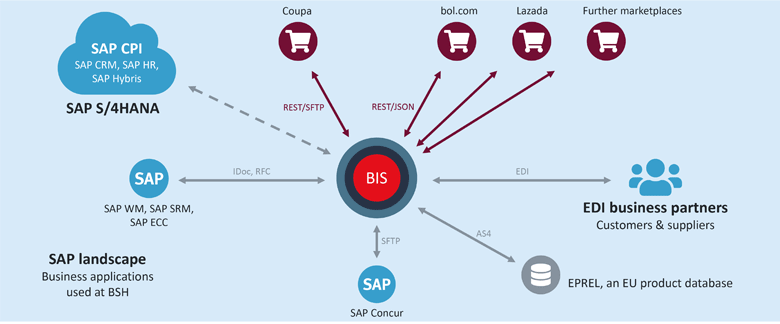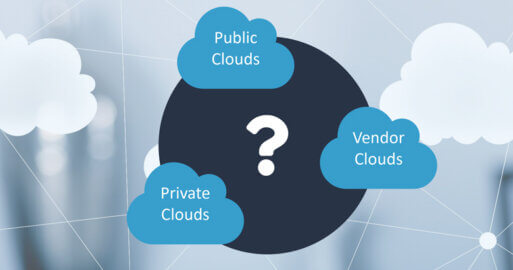Integrating S/4HANA with SAP Applications

In this blog series, we are looking at four main areas in SAP S/4HANA integration. This article looks at integrating S/4HANA with SAP applications. Further posts look at integrating S/4HANA with:
- 3rd party applications and legacy systems
- B2B integration and integrating with
- Public clouds and data lakes

Integrating SAP S/4HANA with SAP applications – is it as easy as it seems?
Did you know that SAP’s full product range consists of approximately 300 products and a further 200 cloud service offerings? You can count these on SAP’s website. SAP S/4HANA is therefore only one component in SAP’s overall range of solutions – albeit the important one at the centre.
If we look at this purely mathematically, SAP’s own portfolio alone could result in more than 150,000 possible point-to-point integrations. Of course, with duplications and individual industry and company needs, no system would be set up with all 500 products. However, it highlights what many SAP users already know – that SAP has found it increasingly difficult to deliver on its original core promise of an ‛integrated application system for all business needs’.
A key driver behind this diversity is the fact that SAP has primarily relied on acquisitions to increase its cloud-based offerings. The most notable examples here are Hybris, SuccessFactors, Fieldglass, Concur, Ariba, and Qualtrics. SAP will be mapping an integration solution for four core operational processes between these applications and SAP S/4HANA. This is helpful and much welcomed by the SAP community, but still leaves a wide range of unresolved integration needs.
These acquired applications have a non-SAP history as they used to be 3rd party applications, and contain various interfaces which can be used to integrate them into a system. These interface technologies, however, are not those generally offered by an SAP ERP system.
SAP have promised to keep the interfaces in all their applications and services open
It is, of course, in SAP’s interest to maintain open interfaces in its applications and services. It tends to be the cloud-based applications such as SuccessFactors which persuade smaller companies to cross the threshold into the SAP world. And openness is crucial to let new customers connect these starter apps into their own IT infrastructure.
What does this mean for SAP S4/HANA users, who need to integrate SAP applications into their central ERP system?
- They can use SAP integrations solutions – but are not compelled to do so.
- They are free to choose the best integration solution for their integration needs.
- They can rest assured that products from SAP will remain integratable in the future, making their investment last. As in this case with SAP BW/HANA.
Many SAP-branded integration solutions originate from third parties. What are the consequences?
This is a relief to many, who had been dreading unpredictable costs for their SAP-to-SAP integration needs. SAP Note 2942344, for example, states that SAP-to-SAP integration for the four core business processes (see above) will only be free of charge if no customisation is necessary. How can users be confident of this at this early stage? Doubts grow as you look more closely at exactly what integration solutions SAP are offering. The SAP Integration Suite “Open Connectors” cloud platform, for example, is provided by partner Cloud Elements. However, the company was acquired by UiPath in March 2021. UiPath is a competitor to SAP in the areas of robotic process automation and process mining. It is therefore questionable whether UiPath has an interest in strengthening its competitor in the future. The strategy of offering third party integrative solutions leaves customers with a lot of risk and uncertainty.
Using the SEEBURGER Business Integration Suite to integrate S/4HANA into your IT infrastructure – smooth and seamless
The diagram below shows how one particular SAP customer removed all uncertainty while still seamlessly integrating the systems, applications, partner and data they need. This included integrating SAP-SAP, both for SAP ECC and the newer SAP S/4HANA. SAP Concur is an example of an SAP cloud-based product. Get the details in the case study.

Find out more about the SEEBURGER solutions for integrating SAP S/4HANA and have a look at our blog posts covering the things you need to consider in this mammoth task. For one thing’s for sure: S/4HANA integration is best left to the experts.
Thank you for your message
We appreciate your interest in SEEBURGER
Get in contact with us:
Please enter details about your project in the message section so we can direct your inquiry to the right consultant.
Written by: Thomas Kamper
Thomas Kamper, SVP Strategic Product Management, is responsible for strategic product initiatives related to all SEEBURGER’s business integration technology and solutions. The focus is currently on API solutions and Big Data. In addition, he is responsible for solutions that enable organizations to master challenges of visibility and to control the proper execution of digitalized business processes. Thomas rejoined SEEBURGER December 2017. Before, he worked for many years as a hands-on interim manager and business advisor supporting C-level executives within software and cloud service providers to make their strategic product initiatives successful.





